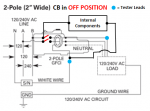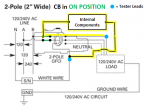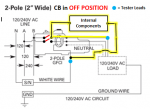Had a strange thing happen the other day. Troubleshooting a 2-pole (240V, class A) GFCI breaker issue and found that when all wires are disconnected from breaker it was measuring roughly 26K-ohm from L1 load terminal to the white neutral pigtail, and about 60K-ohm from L2 load terminal to same pigtail. After measuring this, I thought “that can’t be right” so I had the breaker replaced.
A measurable resistance such as this would mean that there’s automatically some amount of leakage current that would go towards tripping the breaker’s GFCI coil. Granted, they would cancel each other out a bit, but this would mean there’s already several mA of current going toward tripping the GFCI circuit without even a load on it. Must be some type of partial short in the breaker I though. Maybe the test button is partially stuck...
So the new breaker arrives... I open it up and do the same test. Get out of here. Same exact readings. So is this normal? Unless I’m being foolish with something here, this means 4.6mA leakage from L1 and 2 mA leakage from L2... on the breaker itself. Surprisingly high. Or at least not what I personally expected.
A measurable resistance such as this would mean that there’s automatically some amount of leakage current that would go towards tripping the breaker’s GFCI coil. Granted, they would cancel each other out a bit, but this would mean there’s already several mA of current going toward tripping the GFCI circuit without even a load on it. Must be some type of partial short in the breaker I though. Maybe the test button is partially stuck...
So the new breaker arrives... I open it up and do the same test. Get out of here. Same exact readings. So is this normal? Unless I’m being foolish with something here, this means 4.6mA leakage from L1 and 2 mA leakage from L2... on the breaker itself. Surprisingly high. Or at least not what I personally expected.







